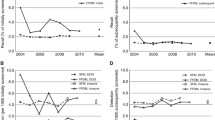Abstract.
The objective of this study was to compare screen-film mammography (SFM) to full-field digital mammography (FFDM) regarding image quality as well as detectability and characterization of lesions using equivalent images of the same patient acquired with both systems. Two mammography units were used, one with a screen-film system (Senographe DMR) and the other with a digital detector (Senographe 2000D, both GEMS). Screen-film and digital mammograms were performed on 55 patients with cytologically or histologically proven tumors on the same day. Together with these, 75 digital mammograms of patients without tumor and the corresponding previous screen-film mammograms not older than 1.5 years were reviewed by three observers in a random order. Contrast, exposure, and the presence of artifacts were evaluated. Different details, such as the skin, the retromamillary region, and the parenchymal structures, were judged according to a three-point ranking scale. Finally, the detectability of microcalcifications and lesions were compared and correlated to histology. Image contrast was judged to be good in 76%, satisfactory in 20%, and unsatisfactory in 4% of screen-film mammograms. Digital mammograms were judged to be good in 99% and unsatisfactory in 1% of cases. Improper exposure of screen-film system occurred in 18% (10% overexposed and 8% underexposed). Digital mammograms were improperly exposed in 4% of all cases but were of acceptable quality after post-processing. Artifacts, most of them of no significance, were found in 78% of screen-film and in none of the digital mammograms. Different anatomical regions, such as the skin, the retromamillary region, and dense parenchymal areas, were better visualized in digital than in screen-film mammography. All malignant tumors were seen by the three radiologists; however, digital mammograms allowed a better characterization of these lesions to the Breast Imaging Reporting and Data System (BI-RADSZZZ;) categories (FFDM better than SFM in 23 of 165 vs 9 of 165 judged cases in SFM). In conclusion, digital mammography offers a consistent, high image quality in combination with a better contrast and without artifacts. Lesion detection in digital images was equal to that in screen-film images; however, categorization of the lesions to the BI-RADS classification was slightly better.
Similar content being viewed by others
Author information
Authors and Affiliations
Additional information
Electronic Publication
An erratum to this article is available at http://dx.doi.org/10.1007/s00330-002-1638-1.
Rights and permissions
About this article
Cite this article
Obenauer, S., Luftner-Nagel, S., von Heyden, D. et al. Screen film vs full-field digital mammography: image quality, detectability and characterization of lesions. Eur Radiol 12, 1697–1702 (2002). https://doi.org/10.1007/s00330-001-1269-y
Received:
Revised:
Accepted:
Published:
Issue Date:
DOI: https://doi.org/10.1007/s00330-001-1269-y




